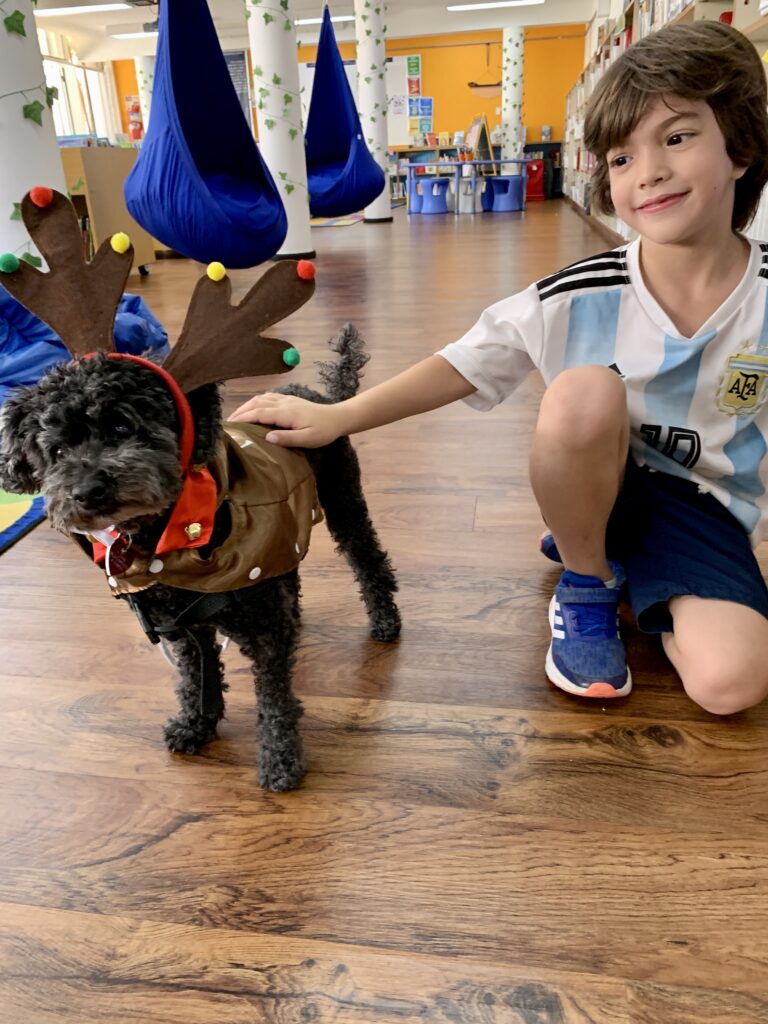
Since 2022, Lincoln has had a therapy dog that provides emotional support to students throughout the school. Gracie joined the community as part of a project that seeks to help students with social learning and emotional well-being.
She has curly hair, bright black eyes, a wet nose, and is always friendly. Who is she? Gracie, the poodle originally from the Netherlands, joined Lincoln as a school therapy dog. Although she was initially just a visitor, accompanying Melissa Cavender, the Elementary School Librarian, her presence quickly turned into a full-time project, and she became a very special friend to everyone in the community.
Lincoln, the international school in Buenos Aires, added Gracie to its staff to provide emotional support to students in all divisions. In April 2022, Lincoln launched Paws to Care, a therapy dog program that encourages all students to pause, take care of themselves, and develop their Social and Emotional Learning, known as SEL. “Every morning Gracie runs from place to place, delivering joy. She is always so excited to say good morning to everyone at Lincoln,” shares Melissa.


WHAT IS A THERAPY DOG?
“With their strong loyalty and deep affection toward humans, therapy dogs assist in the treatment of elderly people, disabled or sick people in improving their mental or physical functions,” the International Therapy Dog Association explains on its official website. These experiences frequently occur in hospitals, nursing homes, and schools.
As a puppy, Gracie had lessons with two private trainers in The Netherlands before attending therapy dog classes in the United States, where she trained and took an exam. Soon after, she and her owner Melissa registered as a team with Project Canine in Washington. They did volunteer work in libraries and an assisted living home. Once settled in Argentina, the duo took another course and exam to be registered with PetPartners Argentina.
WHY HAVE A THERAPY DOG?
Although the benefits are already recognized, therapy dogs are not yet commonly found in schools. Gracie contributes to the well-being of the school community, with specific plans, such as supporting reading; assisting in the development of responsibility and empathy; and improving behaviour, participation, and academic confidence. This helps students of all ages to better understand their emotions, to feel them fully, and to demonstrate empathy for others. At Lincoln, where all members consider themselves learners, it is very inspiring to see that Gracie is one too.
HOW DOES GRACIE HELP OUR COMMUNITY?
She helps manage stress, anxiety, and insecurities. How? She gives love without asking for anything in return, and this boosts self-esteem. “Gracie makes me feel calm and happy because I can pet her and all my worries just disappear,” noted one 3rd grader. She listens patiently without judgement, so students feel safe around her. “I feel great when I read a story to Gracie because she is always excited to see me. She doesn’t care if I make a mistake,” shared a classmate.
Gracie is also loyal and supportive. Her companionship can relieve loneliness and lift spirits when someone is having a rough day. Everyone can be themselves with Gracie. “She made my day better just by being there,” revealed a teenage junior in high school.


PROOF OF THE GRACIE EFFECT
Several types of research show the impact a therapy dog has on students’ well-being and mental health. Research from Washington State University shows that programs like these can relieve stress: “Students in our study that interacted with cats and dogs had a significant reduction in cortisol, a major stress hormone.” This reduction can, over time, have significant physical and mental health benefits.
The bond that is generated between people and animals plays a key role. “When a known animal stares at us our body releases oxytocin. When we stare back the pet will also release the same hormone,” explains Marta Vieira, Doctor of Veterinary Medicine, on the website dedicated to pets, Petable. “That’s why spending time with your pet helps reducing anxiety and keeping the good mood.”
Gracie works every day to reinforce Lincoln’s core commitment: the emotional well-being of its students and fostering an inclusive and empathetic environment. Her presence brings joy and supports the school’s mission of developing students into kind and ethical members of a global community. In this spirit of connection and caring, Gracie and Lincoln demonstrate that, together, we can build a future where honoring diversity and collaborating to improve the world is a reality.






Notas Relacionadas
El Polo Educativo Pilar lanza el reconocimiento al Educador del Año 2024
LATAM Tour de Glifing
La Conferencia Iberoamericana del IB en Bogotá: Innovación y Colaboración Educativa